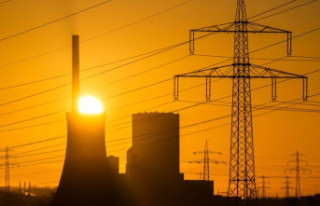Nobody far and wide, and that in the middle of the week. The keel segments for the new cruise ship are abandoned in the construction dock at MV Werften in Rostock-Warnemünde. Parts of the structures in shell construction are in the open spaces around the halls and in the parking lots. In total there are a good 17,000 tons of steel.
During the construction of the “Global 2”, the MV shipyards filed for bankruptcy in January. Workers with welding equipment soon arrive again, but this time not to complete the mighty ship, but to separate the segments with cutting torches – for recycling on the scrap heap. With the scrapping of the "Global 2" fragments, the shipyard workers' dream of building the world's largest cruise ships in Mecklenburg-Western Pomerania comes to an end.
The few employees who are still at the shipyard and other citizens of Rostock are standing in one of the shipyard halls in summer clothes this afternoon and getting to know their possible new employer. The Bundeswehr presents itself with two information mobiles and advertises for workers. The Federal Republic of Germany will take over the shipyard on August 1st so that an arsenal for the German Navy can be built there.
Since the bankruptcy filings in January, the Hamburg insolvency administrator Christoph Morgen from the law firm Brinkmann
Christoph Morgen says goodbye to the remaining employees in Rostock in the hall. "The circumstances have changed fundamentally since the start of the insolvency proceedings in January," says the 46-year-old when he looks at the steel segments in the dry dock. "The Russian war of aggression against Ukraine since February has resulted in a higher perspective need for new construction and maintenance capacity for the German Navy and other European navies." Ultimately, this increased the chances of selling the Wismar shipyard to ThyssenKruppp Marine Systems (TKMS). and the shipyard in Rostock-Warnemünde to the federal government.
In Wismar, TKMS wants to build submarines from 2024, in Stralsund the city is planning a maritime industrial and commercial park after taking over the shipyard. In Bremerhaven, the new owners, the companies Rönner and Zech, want to re-establish Lloyd Werft in the market for the repair of cruise ships and for the construction of yachts and special ships.
The tourism and gaming group Genting Hong Kong had aligned the three MV shipyards and the Lloyd shipyard since 2016 to build cruise ships of various sizes. The "Global Dream" and the "Global 2" for up to 9500 passengers and 2500 people crew, especially for the Chinese market, should be the largest cruise ships in the world - and, measured by their capacity, the largest passenger ships ever in the world history of seafaring.
At the beginning of the year, Genting Hong Kong filed for bankruptcy for its German shipyards, mainly driven by the consequences of the pandemic for the cruise industry in China. The most extensive insolvency proceedings in German shipbuilding since the sinking of the Bremer Vulkan in the mid-1990s began. "I applied to the District Court of Schwerin to take on this mandate, and we as a law firm have prepared for it," says Morgen. "Because a possible insolvency had been threatening for weeks around the turn of the year - with all the far-reaching consequences for shipbuilding, especially in Mecklenburg-Western Pomerania, which we then saw."
It was probably the most demanding task so far for the lawyer and tax consultant who has a doctorate. "The first half of the year was exceptional for me, with more than 100 hours of work a week," he says. "We implemented nine sales processes in a very short time, at times almost 100 people were involved, in addition to around 40 colleagues from Brinkmann
And it wasn't just an accumulation of insolvencies with four shipyards and their subsidiaries - but a support campaign for German shipbuilding as a whole, which is under pressure like it hasn't been for a long time due to the pandemic and the current economic crisis. “In a very special way, it was about striking a balance between representing the interests of the creditors and saving as many jobs as possible at the same time,” says Morgen. His law firm will probably be busy completing all the work on this big case for another five years. He was able to keep most of the around 2,200 jobs previously.
The shipbuilding industry pays tribute to Tomorrow. "From the employees' point of view, one can say that Mr. Morgen did a good job under these difficult circumstances," says Ines Scheel, Chairwoman of the Works Council at MV Werften, who has seen many changes of ownership and some insolvencies in East German shipbuilding since German reunification. "There was always very open communication with the employee representatives, the workforce and IG Metall on the status of the insolvency proceedings."
Reinhard Lüken, Managing Director of the Association for Shipbuilding and Marine Technology in Hamburg, says: “Solutions were found for all four locations, and industrial use is still guaranteed. From our point of view, optimal use did not result everywhere. But it goes on. And that is crucial.”
From the point of view of the trade union IG Metall, the key industry in Mecklenburg-Western Pomerania threatened to break away with the MV shipyards. “We have been in close and intensive contact with the insolvency administrator Christoph Morgen from day one. It's not just about collecting as much money as possible for the creditors, but also about prospects for the locations and the employees," says Heiko Messerschmidt, member of the district management at IG Metall Coast in Hamburg. Morgen is "not a developer, but a designer who keeps an eye on the sometimes conflicting interests of all those involved".
The situation at the shipyard in Stralsund initially remains problematic, the prospects for the industrial and commercial park are not yet clear. “Insolvency proceedings in themselves are not industrial policy. This also requires active federal and state governments,” demands Messerschmidt. In Warnemünde, it is now a matter of relocating the offshore wind power industry, which was previously active there, in addition to the future arsenal for the German Navy on part of the shipyard area: “We are relying on more support from the Federal Ministry of Economics for this.”
Christoph Morgen now dedicates himself to the final at MV Werften. In the afternoon he drives from Rostock to the shipyard in Wismar. There the “Global Dream” lies in the dry dock of the construction hall, largely finished on the outside and already painted with a heroic decor specially designed for China. About three quarters of the way through, it has been the largest ghost ship in the world for months. When walking across the deserted decks, it seems as if the workers could be right back.
Coiled electric cables hang out of the shafts in the ceiling, the ship's bridge still has no floor panels or control panels. A large part of the interior is missing, the bars, restaurants and casinos where thousands of passengers are supposed to have fun. The whirlpools on the upper decks are still bare steel, and the children's playground is half-completed. More than 3,000 of the approximately 3,300 cabins have already been installed, as well as the machines, electrical units and much more. A prison cell was planned for the house-high ship as well as a cold chamber for deaths.
On the quay next to the building dock there are thousands of individual parts that still have to be installed, including the orange water slide for the fun pool on deck. A custom-made roller coaster for wild rides high above the sea on the "Global Dream" is stored in a neighboring hall.
The insolvency administrator wants the shipyard workers to return from the transfer company and complete the giant. The hall can be used to complete the 342 meter long, 46 meter wide "Global Dream" by the end of 2023, as agreed with the new owner TKMS. In view of the lockdowns in China, it seems doubtful that the ship will still be cruising off China's coasts in the future. "For a few million euros, the interior of the cabins could be adapted to the European and American markets," says Morgen. "The ship would then have a capacity of 5,000 to 6,000 passengers."
Around 1.3 billion euros have been installed on the "Global Dream" so far, and a further 700 million euros are still needed to complete it: "Financing would only be possible if a reliable buyer contributed equity," says Morgen. The “Global Dream” was originally supposed to cost 1.6 billion euros.
Genting Hong Kong lost more than 600 million euros in investments in the ship with the insolvency of MV Werften. A further 600 million euros in loans from a total of 16 banks are still outstanding. The state of Mecklenburg-Western Pomerania guarantees part of these construction financing loans. There is a risk, says Morgen, "that guarantees of up to 275 million euros will be called upon".
How much a buyer pays for the ship in the end also depends on what part of their loans the banks waive. If the country were to take over its guarantee in full, there would be open loans of 325 million euros. Added to the costs that would also be necessary for completion, the "Global Dream" could cost a new investor around one billion euros - but maybe significantly less.
However, if Tomorrow does not find an operator for the ship, its first – and last – journey will probably be to Aliağa in western Turkey, north of Izmir, without its own propulsion, on the hawsers of tugboats. Shipyards there specialize in breaking up huge ships in compliance with EU standards. In the “Global Dream”, around 70,000 tons of steel, more than 8,500 kilometers of electrical cable and a few million working hours would then be “recycled”, as Morgen says.
The insolvency administrator would probably have to sell the approximately 5,000 mattresses from the cabins and crew quarters separately. Nothing is decided yet. But he also calculated the saddest case: "If the 'Global Dream' were recycled, it would probably be possible to achieve at least a black zero - also in view of the currently good steel price - despite the high costs for undocking and towing," says he. "And possibly even an excess."












